Analyzing Transformation Failures: A Change Management Perspective
VerifiedAdded on 2023/06/11
|8
|1919
|226
Essay
AI Summary
This essay delves into the reasons why organizational transformation efforts often fail, emphasizing the critical role of leadership and change management. It begins by highlighting the importance of creating a sense of urgency and a clear vision within the organization, using examples such as General Motors and Blockbuster to illustrate the consequences of failing to adapt to changing market dynamics. The essay also discusses the significance of removing obstacles to the new vision, as demonstrated by the case of Toys “R” Us. To address these challenges, the essay recommends adopting Kotter’s eight-step change model, which focuses on creating a climate for change, linking the change to the organization, and implementing the change effectively. The conclusion underscores the high failure rate of Fortune 500 companies due to inefficient change management and reiterates the importance of proactive and strategic change implementation for sustained success. Desklib provides this essay and other solved assignments to aid students in their studies.
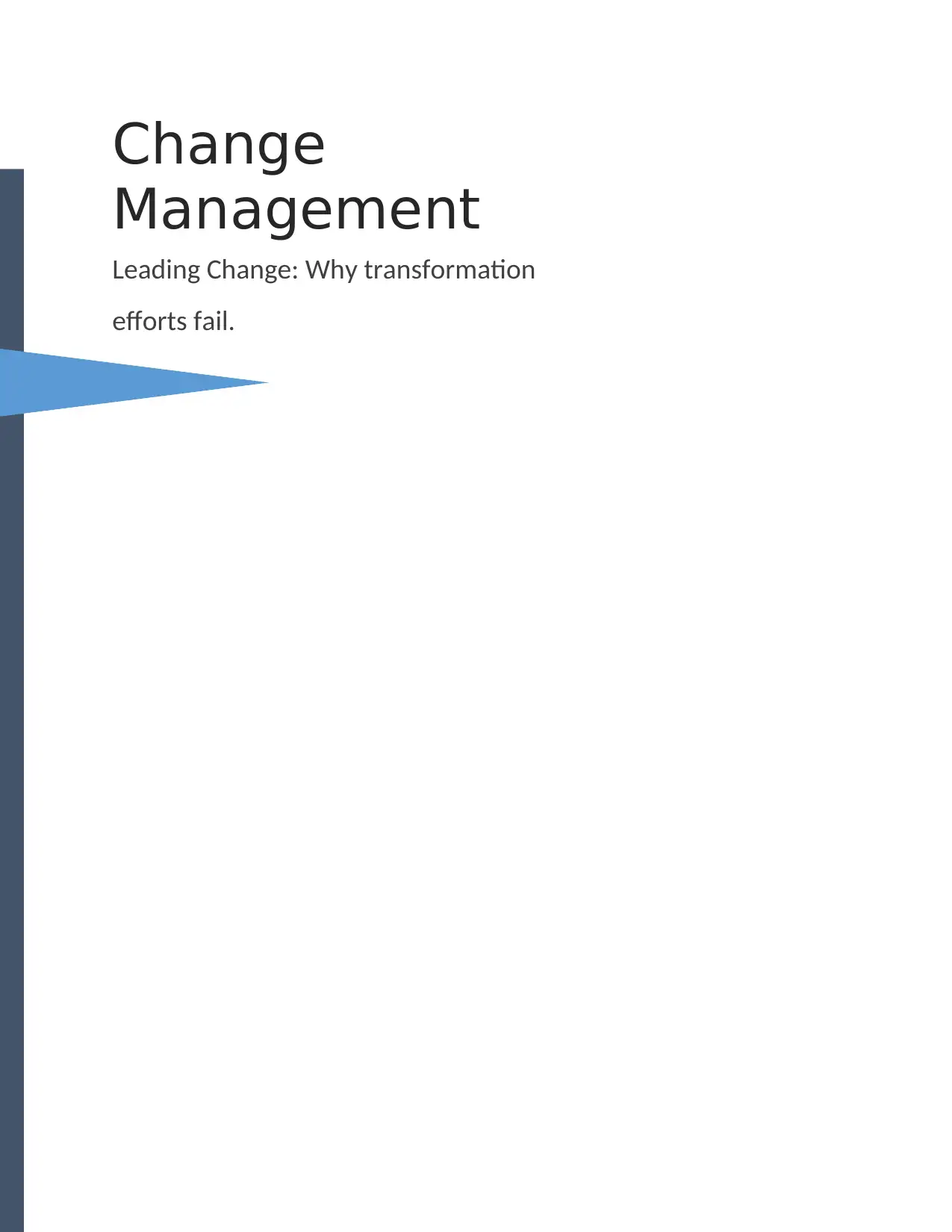
Change
Management
Leading Change: Why transformation
efforts fail.
Management
Leading Change: Why transformation
efforts fail.
Paraphrase This Document
Need a fresh take? Get an instant paraphrase of this document with our AI Paraphraser
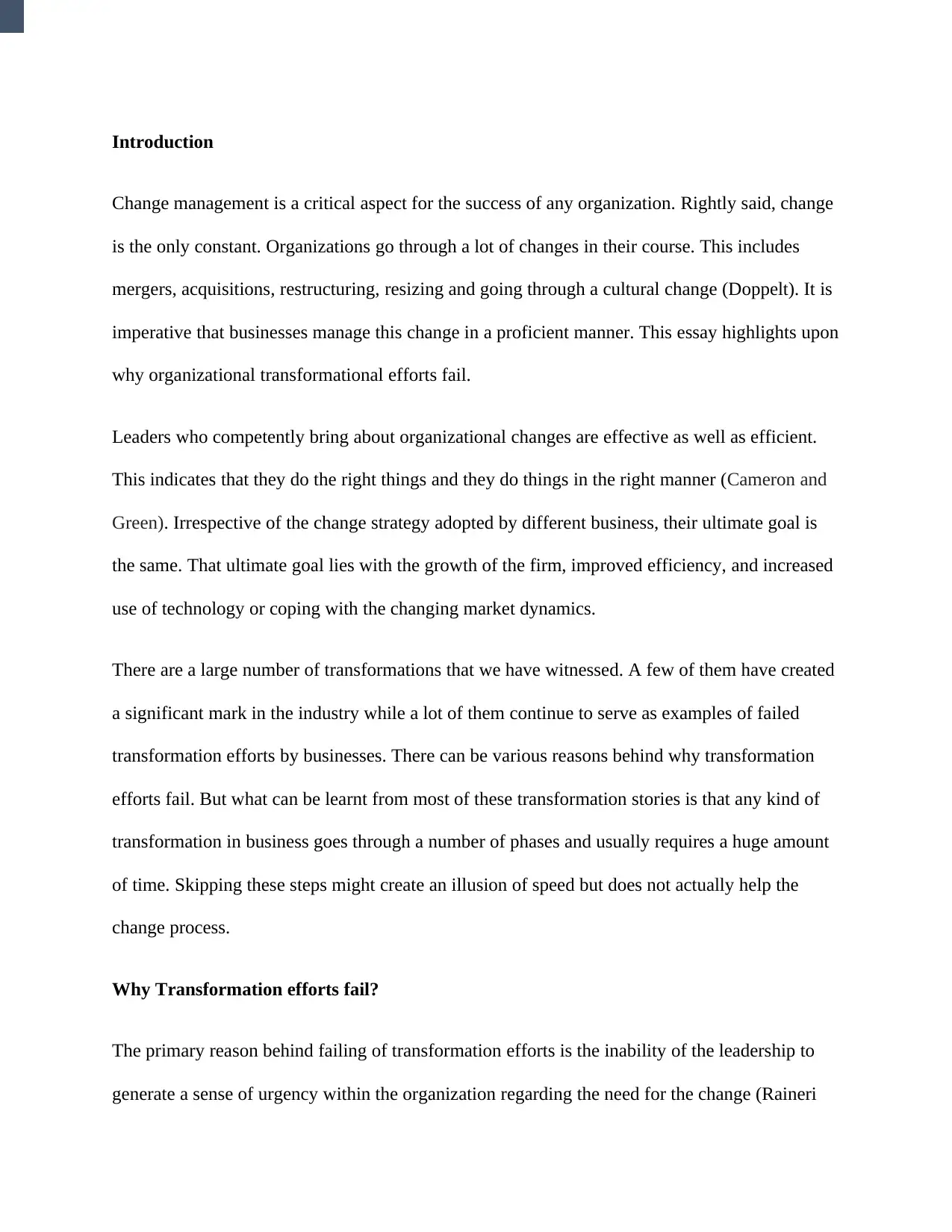
Introduction
Change management is a critical aspect for the success of any organization. Rightly said, change
is the only constant. Organizations go through a lot of changes in their course. This includes
mergers, acquisitions, restructuring, resizing and going through a cultural change (Doppelt). It is
imperative that businesses manage this change in a proficient manner. This essay highlights upon
why organizational transformational efforts fail.
Leaders who competently bring about organizational changes are effective as well as efficient.
This indicates that they do the right things and they do things in the right manner (Cameron and
Green). Irrespective of the change strategy adopted by different business, their ultimate goal is
the same. That ultimate goal lies with the growth of the firm, improved efficiency, and increased
use of technology or coping with the changing market dynamics.
There are a large number of transformations that we have witnessed. A few of them have created
a significant mark in the industry while a lot of them continue to serve as examples of failed
transformation efforts by businesses. There can be various reasons behind why transformation
efforts fail. But what can be learnt from most of these transformation stories is that any kind of
transformation in business goes through a number of phases and usually requires a huge amount
of time. Skipping these steps might create an illusion of speed but does not actually help the
change process.
Why Transformation efforts fail?
The primary reason behind failing of transformation efforts is the inability of the leadership to
generate a sense of urgency within the organization regarding the need for the change (Raineri
Change management is a critical aspect for the success of any organization. Rightly said, change
is the only constant. Organizations go through a lot of changes in their course. This includes
mergers, acquisitions, restructuring, resizing and going through a cultural change (Doppelt). It is
imperative that businesses manage this change in a proficient manner. This essay highlights upon
why organizational transformational efforts fail.
Leaders who competently bring about organizational changes are effective as well as efficient.
This indicates that they do the right things and they do things in the right manner (Cameron and
Green). Irrespective of the change strategy adopted by different business, their ultimate goal is
the same. That ultimate goal lies with the growth of the firm, improved efficiency, and increased
use of technology or coping with the changing market dynamics.
There are a large number of transformations that we have witnessed. A few of them have created
a significant mark in the industry while a lot of them continue to serve as examples of failed
transformation efforts by businesses. There can be various reasons behind why transformation
efforts fail. But what can be learnt from most of these transformation stories is that any kind of
transformation in business goes through a number of phases and usually requires a huge amount
of time. Skipping these steps might create an illusion of speed but does not actually help the
change process.
Why Transformation efforts fail?
The primary reason behind failing of transformation efforts is the inability of the leadership to
generate a sense of urgency within the organization regarding the need for the change (Raineri
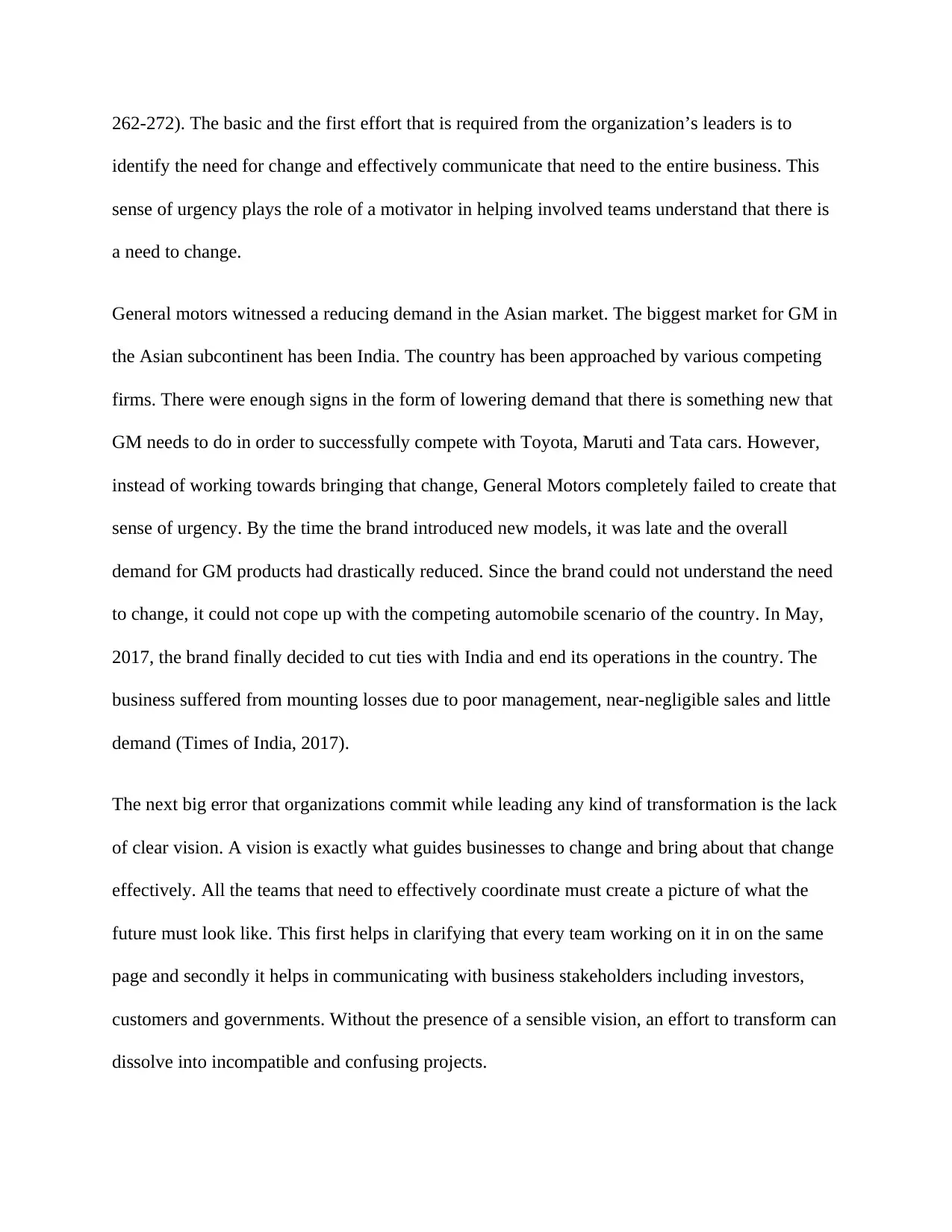
262-272). The basic and the first effort that is required from the organization’s leaders is to
identify the need for change and effectively communicate that need to the entire business. This
sense of urgency plays the role of a motivator in helping involved teams understand that there is
a need to change.
General motors witnessed a reducing demand in the Asian market. The biggest market for GM in
the Asian subcontinent has been India. The country has been approached by various competing
firms. There were enough signs in the form of lowering demand that there is something new that
GM needs to do in order to successfully compete with Toyota, Maruti and Tata cars. However,
instead of working towards bringing that change, General Motors completely failed to create that
sense of urgency. By the time the brand introduced new models, it was late and the overall
demand for GM products had drastically reduced. Since the brand could not understand the need
to change, it could not cope up with the competing automobile scenario of the country. In May,
2017, the brand finally decided to cut ties with India and end its operations in the country. The
business suffered from mounting losses due to poor management, near-negligible sales and little
demand (Times of India, 2017).
The next big error that organizations commit while leading any kind of transformation is the lack
of clear vision. A vision is exactly what guides businesses to change and bring about that change
effectively. All the teams that need to effectively coordinate must create a picture of what the
future must look like. This first helps in clarifying that every team working on it in on the same
page and secondly it helps in communicating with business stakeholders including investors,
customers and governments. Without the presence of a sensible vision, an effort to transform can
dissolve into incompatible and confusing projects.
identify the need for change and effectively communicate that need to the entire business. This
sense of urgency plays the role of a motivator in helping involved teams understand that there is
a need to change.
General motors witnessed a reducing demand in the Asian market. The biggest market for GM in
the Asian subcontinent has been India. The country has been approached by various competing
firms. There were enough signs in the form of lowering demand that there is something new that
GM needs to do in order to successfully compete with Toyota, Maruti and Tata cars. However,
instead of working towards bringing that change, General Motors completely failed to create that
sense of urgency. By the time the brand introduced new models, it was late and the overall
demand for GM products had drastically reduced. Since the brand could not understand the need
to change, it could not cope up with the competing automobile scenario of the country. In May,
2017, the brand finally decided to cut ties with India and end its operations in the country. The
business suffered from mounting losses due to poor management, near-negligible sales and little
demand (Times of India, 2017).
The next big error that organizations commit while leading any kind of transformation is the lack
of clear vision. A vision is exactly what guides businesses to change and bring about that change
effectively. All the teams that need to effectively coordinate must create a picture of what the
future must look like. This first helps in clarifying that every team working on it in on the same
page and secondly it helps in communicating with business stakeholders including investors,
customers and governments. Without the presence of a sensible vision, an effort to transform can
dissolve into incompatible and confusing projects.
⊘ This is a preview!⊘
Do you want full access?
Subscribe today to unlock all pages.

Trusted by 1+ million students worldwide
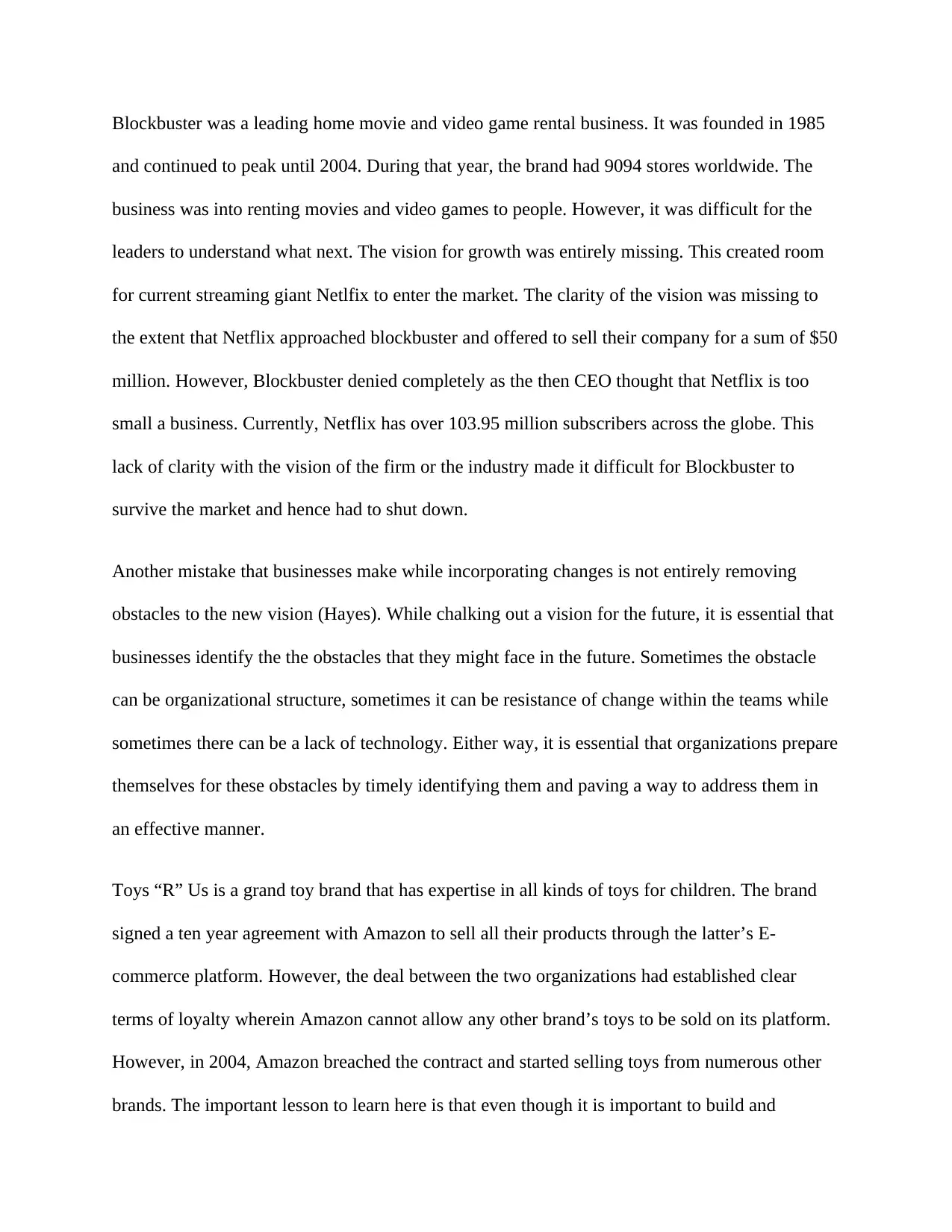
Blockbuster was a leading home movie and video game rental business. It was founded in 1985
and continued to peak until 2004. During that year, the brand had 9094 stores worldwide. The
business was into renting movies and video games to people. However, it was difficult for the
leaders to understand what next. The vision for growth was entirely missing. This created room
for current streaming giant Netlfix to enter the market. The clarity of the vision was missing to
the extent that Netflix approached blockbuster and offered to sell their company for a sum of $50
million. However, Blockbuster denied completely as the then CEO thought that Netflix is too
small a business. Currently, Netflix has over 103.95 million subscribers across the globe. This
lack of clarity with the vision of the firm or the industry made it difficult for Blockbuster to
survive the market and hence had to shut down.
Another mistake that businesses make while incorporating changes is not entirely removing
obstacles to the new vision (Hayes). While chalking out a vision for the future, it is essential that
businesses identify the the obstacles that they might face in the future. Sometimes the obstacle
can be organizational structure, sometimes it can be resistance of change within the teams while
sometimes there can be a lack of technology. Either way, it is essential that organizations prepare
themselves for these obstacles by timely identifying them and paving a way to address them in
an effective manner.
Toys “R” Us is a grand toy brand that has expertise in all kinds of toys for children. The brand
signed a ten year agreement with Amazon to sell all their products through the latter’s E-
commerce platform. However, the deal between the two organizations had established clear
terms of loyalty wherein Amazon cannot allow any other brand’s toys to be sold on its platform.
However, in 2004, Amazon breached the contract and started selling toys from numerous other
brands. The important lesson to learn here is that even though it is important to build and
and continued to peak until 2004. During that year, the brand had 9094 stores worldwide. The
business was into renting movies and video games to people. However, it was difficult for the
leaders to understand what next. The vision for growth was entirely missing. This created room
for current streaming giant Netlfix to enter the market. The clarity of the vision was missing to
the extent that Netflix approached blockbuster and offered to sell their company for a sum of $50
million. However, Blockbuster denied completely as the then CEO thought that Netflix is too
small a business. Currently, Netflix has over 103.95 million subscribers across the globe. This
lack of clarity with the vision of the firm or the industry made it difficult for Blockbuster to
survive the market and hence had to shut down.
Another mistake that businesses make while incorporating changes is not entirely removing
obstacles to the new vision (Hayes). While chalking out a vision for the future, it is essential that
businesses identify the the obstacles that they might face in the future. Sometimes the obstacle
can be organizational structure, sometimes it can be resistance of change within the teams while
sometimes there can be a lack of technology. Either way, it is essential that organizations prepare
themselves for these obstacles by timely identifying them and paving a way to address them in
an effective manner.
Toys “R” Us is a grand toy brand that has expertise in all kinds of toys for children. The brand
signed a ten year agreement with Amazon to sell all their products through the latter’s E-
commerce platform. However, the deal between the two organizations had established clear
terms of loyalty wherein Amazon cannot allow any other brand’s toys to be sold on its platform.
However, in 2004, Amazon breached the contract and started selling toys from numerous other
brands. The important lesson to learn here is that even though it is important to build and
Paraphrase This Document
Need a fresh take? Get an instant paraphrase of this document with our AI Paraphraser
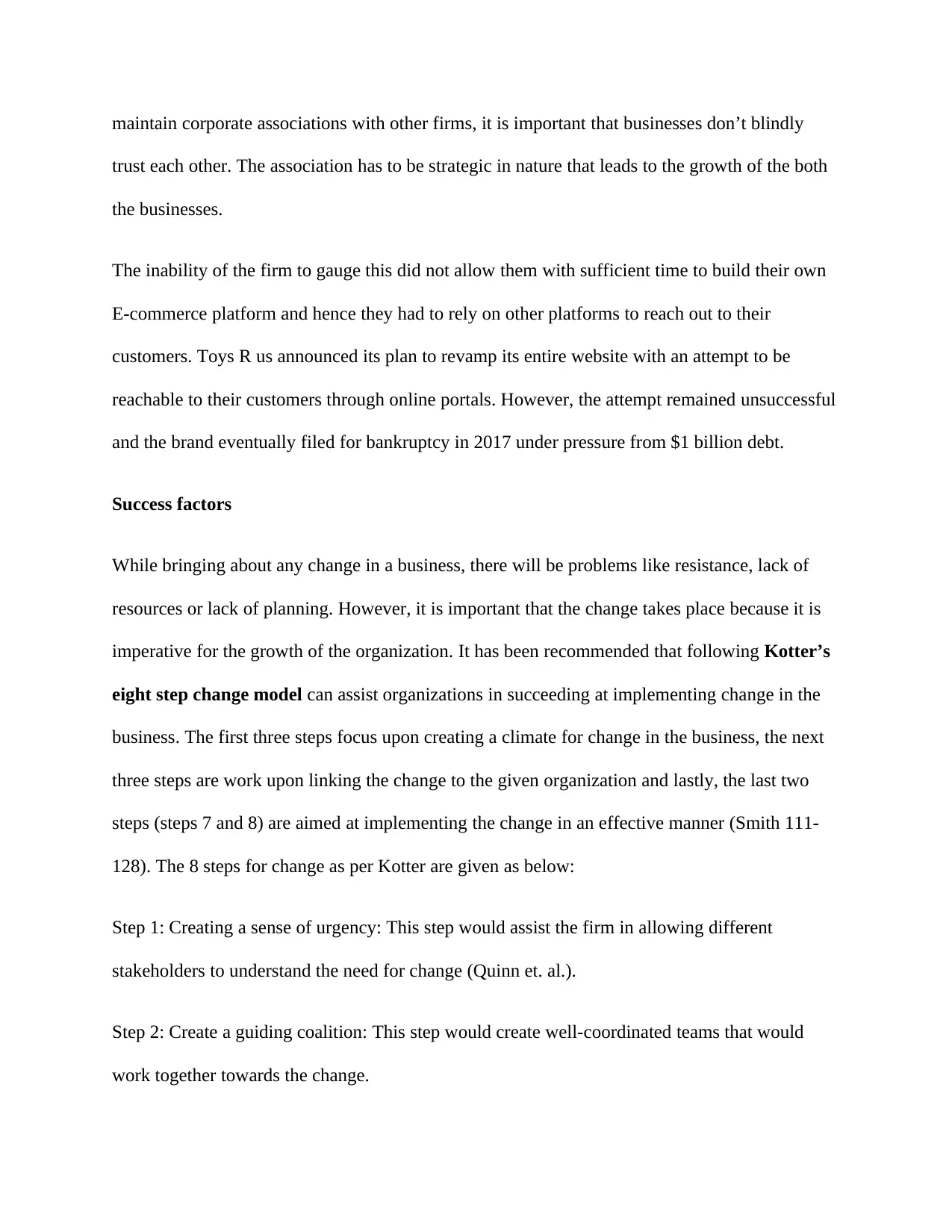
maintain corporate associations with other firms, it is important that businesses don’t blindly
trust each other. The association has to be strategic in nature that leads to the growth of the both
the businesses.
The inability of the firm to gauge this did not allow them with sufficient time to build their own
E-commerce platform and hence they had to rely on other platforms to reach out to their
customers. Toys R us announced its plan to revamp its entire website with an attempt to be
reachable to their customers through online portals. However, the attempt remained unsuccessful
and the brand eventually filed for bankruptcy in 2017 under pressure from $1 billion debt.
Success factors
While bringing about any change in a business, there will be problems like resistance, lack of
resources or lack of planning. However, it is important that the change takes place because it is
imperative for the growth of the organization. It has been recommended that following Kotter’s
eight step change model can assist organizations in succeeding at implementing change in the
business. The first three steps focus upon creating a climate for change in the business, the next
three steps are work upon linking the change to the given organization and lastly, the last two
steps (steps 7 and 8) are aimed at implementing the change in an effective manner (Smith 111-
128). The 8 steps for change as per Kotter are given as below:
Step 1: Creating a sense of urgency: This step would assist the firm in allowing different
stakeholders to understand the need for change (Quinn et. al.).
Step 2: Create a guiding coalition: This step would create well-coordinated teams that would
work together towards the change.
trust each other. The association has to be strategic in nature that leads to the growth of the both
the businesses.
The inability of the firm to gauge this did not allow them with sufficient time to build their own
E-commerce platform and hence they had to rely on other platforms to reach out to their
customers. Toys R us announced its plan to revamp its entire website with an attempt to be
reachable to their customers through online portals. However, the attempt remained unsuccessful
and the brand eventually filed for bankruptcy in 2017 under pressure from $1 billion debt.
Success factors
While bringing about any change in a business, there will be problems like resistance, lack of
resources or lack of planning. However, it is important that the change takes place because it is
imperative for the growth of the organization. It has been recommended that following Kotter’s
eight step change model can assist organizations in succeeding at implementing change in the
business. The first three steps focus upon creating a climate for change in the business, the next
three steps are work upon linking the change to the given organization and lastly, the last two
steps (steps 7 and 8) are aimed at implementing the change in an effective manner (Smith 111-
128). The 8 steps for change as per Kotter are given as below:
Step 1: Creating a sense of urgency: This step would assist the firm in allowing different
stakeholders to understand the need for change (Quinn et. al.).
Step 2: Create a guiding coalition: This step would create well-coordinated teams that would
work together towards the change.

Step 3: Create a vision for change: This step would require the previously created teams to chalk
out a vision for the change.
Step 4: Communicate the vision: This is an essential step as it helps in creating support and
acceptance among employees regarding the upcoming change that they are about to experience.
Step 5: Remove obstacles: This step requires the teams involved to identify the obstacles if any
and work towards removing them in an effective manner and being prepared if they arise again.
Step 6: Create short term wins: Nothing motivates more than success. This step helps in creating
short terms wins to motivate the team and ensure that the project of change management is on
track.
Step 7: Consolidate improvements: Change is a slow process and only after a series of prior
mentioned small wins can change actually be felt. This is the right time to announce the victory
to organizational stakeholders.
Step 8: Anchor the changes: This is the last step of the change process and involves bringing that
change to different parts of the business and ensuring that the new change merges in the DNA of
the firm at the very core of it.
Conclusion
Over 88% of the Fortune 500 companies that existed in 1955 no longer exist. Either they have
merged with other firms, or they have filed for bankruptcy, or they still exist but are not listed as
one of the Fortune 500 firms. This is because of inefficient change management strategies
adopted by businesses. There are various organizations who have not been able to see the light of
out a vision for the change.
Step 4: Communicate the vision: This is an essential step as it helps in creating support and
acceptance among employees regarding the upcoming change that they are about to experience.
Step 5: Remove obstacles: This step requires the teams involved to identify the obstacles if any
and work towards removing them in an effective manner and being prepared if they arise again.
Step 6: Create short term wins: Nothing motivates more than success. This step helps in creating
short terms wins to motivate the team and ensure that the project of change management is on
track.
Step 7: Consolidate improvements: Change is a slow process and only after a series of prior
mentioned small wins can change actually be felt. This is the right time to announce the victory
to organizational stakeholders.
Step 8: Anchor the changes: This is the last step of the change process and involves bringing that
change to different parts of the business and ensuring that the new change merges in the DNA of
the firm at the very core of it.
Conclusion
Over 88% of the Fortune 500 companies that existed in 1955 no longer exist. Either they have
merged with other firms, or they have filed for bankruptcy, or they still exist but are not listed as
one of the Fortune 500 firms. This is because of inefficient change management strategies
adopted by businesses. There are various organizations who have not been able to see the light of
⊘ This is a preview!⊘
Do you want full access?
Subscribe today to unlock all pages.

Trusted by 1+ million students worldwide

the day owing to ineffective change management practices. The various case studies discussed
above help throw light on various reasons behind ineffective change management. In order to
address the same, Kotter’s eight step model has been discussed which reflects upon various steps
that can be adopted in order to effectively bring about change in any business.
above help throw light on various reasons behind ineffective change management. In order to
address the same, Kotter’s eight step model has been discussed which reflects upon various steps
that can be adopted in order to effectively bring about change in any business.
Paraphrase This Document
Need a fresh take? Get an instant paraphrase of this document with our AI Paraphraser
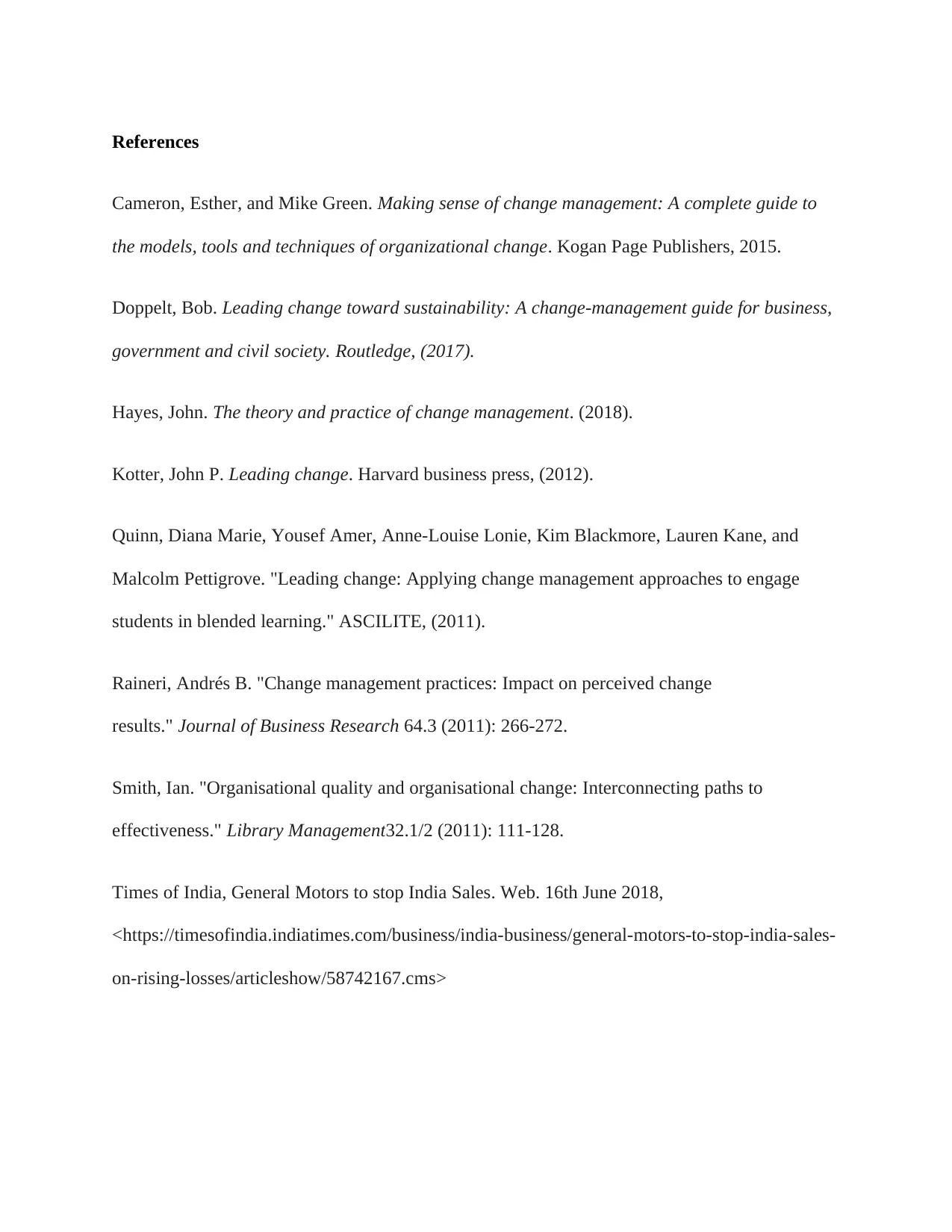
References
Cameron, Esther, and Mike Green. Making sense of change management: A complete guide to
the models, tools and techniques of organizational change. Kogan Page Publishers, 2015.
Doppelt, Bob. Leading change toward sustainability: A change-management guide for business,
government and civil society. Routledge, (2017).
Hayes, John. The theory and practice of change management. (2018).
Kotter, John P. Leading change. Harvard business press, (2012).
Quinn, Diana Marie, Yousef Amer, Anne-Louise Lonie, Kim Blackmore, Lauren Kane, and
Malcolm Pettigrove. "Leading change: Applying change management approaches to engage
students in blended learning." ASCILITE, (2011).
Raineri, Andrés B. "Change management practices: Impact on perceived change
results." Journal of Business Research 64.3 (2011): 266-272.
Smith, Ian. "Organisational quality and organisational change: Interconnecting paths to
effectiveness." Library Management32.1/2 (2011): 111-128.
Times of India, General Motors to stop India Sales. Web. 16th June 2018,
<https://timesofindia.indiatimes.com/business/india-business/general-motors-to-stop-india-sales-
on-rising-losses/articleshow/58742167.cms>
Cameron, Esther, and Mike Green. Making sense of change management: A complete guide to
the models, tools and techniques of organizational change. Kogan Page Publishers, 2015.
Doppelt, Bob. Leading change toward sustainability: A change-management guide for business,
government and civil society. Routledge, (2017).
Hayes, John. The theory and practice of change management. (2018).
Kotter, John P. Leading change. Harvard business press, (2012).
Quinn, Diana Marie, Yousef Amer, Anne-Louise Lonie, Kim Blackmore, Lauren Kane, and
Malcolm Pettigrove. "Leading change: Applying change management approaches to engage
students in blended learning." ASCILITE, (2011).
Raineri, Andrés B. "Change management practices: Impact on perceived change
results." Journal of Business Research 64.3 (2011): 266-272.
Smith, Ian. "Organisational quality and organisational change: Interconnecting paths to
effectiveness." Library Management32.1/2 (2011): 111-128.
Times of India, General Motors to stop India Sales. Web. 16th June 2018,
<https://timesofindia.indiatimes.com/business/india-business/general-motors-to-stop-india-sales-
on-rising-losses/articleshow/58742167.cms>
1 out of 8
Related Documents
Your All-in-One AI-Powered Toolkit for Academic Success.
+13062052269
info@desklib.com
Available 24*7 on WhatsApp / Email
![[object Object]](/_next/static/media/star-bottom.7253800d.svg)
Unlock your academic potential
Copyright © 2020–2025 A2Z Services. All Rights Reserved. Developed and managed by ZUCOL.





